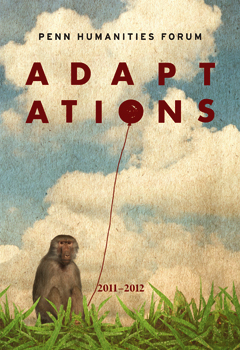Topic Director: Warren Breckman
Associate Professor of History, Penn
Charles Darwin made us re-imagine life as a process of adaptation, with organisms, species, and environments swept up in an unending dance of adjustment and transformation. Darwinian adaptation admits neither change without meaning nor meaning without change; it is instead a complex, ongoing set of responses to stimuli and information for the sake of survival. Yet Darwin’s is just one meaning of adaptation with contemporary salience. Adaptation also signifies the adequation of one thing to another and the displacement of things from one form or context to another. These processes are rampant in our media-saturated, globalized society, where the voraciousness of commerce throws up ever new technologies for transforming, translating, and recombining aspects of the world.
Culture is a partner in the dance of adaptation, and so, willi-nilly, are the humanities. When an environment changes or a group changes environments, the whole structure of its culture adapts; when groups encounter one another, they react and adjust. Individuals who move into new contexts, settings, and circles may “pass,” re-fashion themselves, form and perform different identities. The same shifts occur in encounters of languages, styles, indeed, all cultural products.
Adaptations are made, not merely undergone. We adapt a tool to meet a new use, a building to suit new residents, a ritual to accommodate new beliefs, a law to fit new circumstances. Perhaps nowhere is adaptation more plainly visible than in the arts, which have always reinterpreted pre-existing works, genres and forms in order to open new expressive possibilities. Indeed, at one time or another, all the arts remake each other in some fashion, high-handedly appropriating earlier works as aesthetic quotations, recontextualizing them in collage and pastiche, subverting them in parody and caricature, altering them in performance, and extending their sensory reach through multimedia augmentation. What can we learn by opening a conversation among students of artistic adaptations and those concerned with adaptive phenomena outside of art?
The word “adaptation” refers to a creative process involving time, relationship, and interaction, but it is equally the name for the synchronic product or work at the end of the process. By that point, the factors that have driven the adaptive process are often forgotten, and acts of historical or genealogical excavation may be required for their recovery. How do we decide whether an adaptation has been successful? In the biological sciences, a deceptively simple answer has been that successful adaptations enhance survival. What might such a claim mean when extended to culture? The long history of misapplied evolutionary theory may well warn us to be cautious here.
Part of the meaning of every artistic adaptation lies in its belatedness, even when its origins in an earlier work are obscured. A traditional preoccupation of humanistic scholarship has been the search for “sources and analogues,” the attempt to uncover the adaptation process behind cultural products: the way Shakespeare, for example, transformed ancient chronicles into enduring dramas or the way sacred texts have inspired secular writing in all literate cultures. Today, given the adaptation mill of film, television, and video games, knowledge of a source work often makes us hyper-conscious of what has been lost in the transfer. But what are the ideological assumptions behind our belief that fidelity to a source is a virtue? The chief value of adaptations, on the contrary, may well be the light they shed on the formal constraints and conventions of media that determine what can or cannot be carried over from one to the other.
Adaptations always challenge categories and the social contracts they entail. What does it take for an adaptation to stake its claim as a new invention in its own right rather than merely a variant of something else? Whether in the life sciences or the humanities, any study of adaptive processes must recognize that adaptation is not only the consummate model of gradual change, but also of great punctuations. In society as in art, adaptation may be a form of accommodation, of “fitting in” and compromise; but wittingly or unwittingly, it may also be a recipe for revolution.
With these questions before us, the Penn Humanities Forum invites the members of the public and the university community to join in its 2011-2012 conversations on the topic of Adaptations.
Warren Breckman
May 2010



